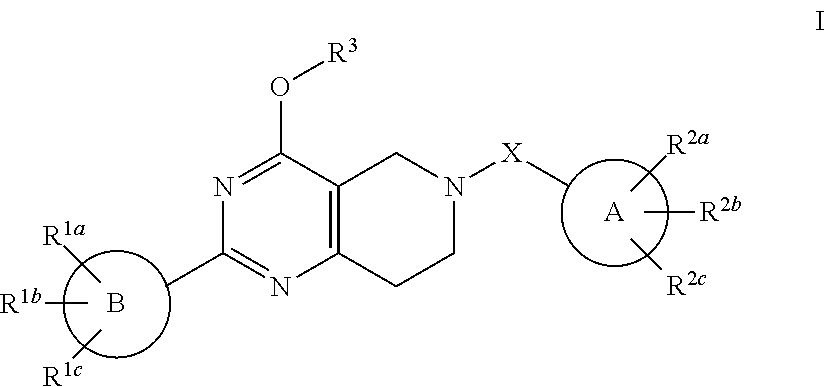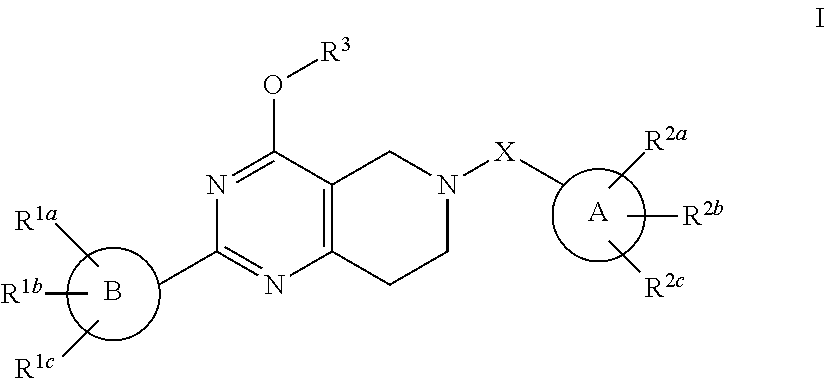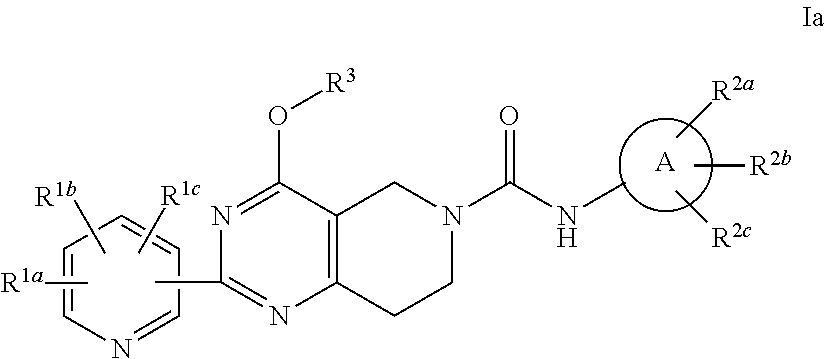Alkoxy tetrahydro-pyridopyrimidine PDE10 inhibitors
a technology of pyrimidine and tetrahydropyrimidine, which is applied in the direction of heterocyclic compound active ingredients, biocide, drug compositions, etc., can solve the problems of high noncomplicance or discontinuation rate of medication, lack of efficacy, and dissatisfaction with therapy
- Summary
- Abstract
- Description
- Claims
- Application Information
AI Technical Summary
Benefits of technology
Problems solved by technology
Method used
Image
Examples
example 1
[0181]
1-tert-butyl 3-ethyl 4-oxopiperidine-1,3-dicarboxylate (A-1)
[0182]A suspension of ethyl-4-piperidone-3-carboxylate hydrochloride (10 g, 48.2 mmol) in CH2Cl2 (400 mL) was treated with TEA (20.14 mL, 144 mmol) and Boc-anhydride (13.42 mL, 57.8 mmol). The mixture was stirred at 23° C. for 5 days. The mixture was diluted with CH2Cl2 (400 mL) and washed with sat. aq. NaHCO3 (400 mL) and brine (400 mL). The organic phase was dried over Na2SO4, filtered, and concentrated in vacuo. The crude material was purified by gradient elution on silica gel (0 to 30% EtOAc in hexanes) to afford the title compound as a white solid (12.3 g, 94%). Data for A-1, all spectral data matched literature values (Solymar, M., et al. Tetrahedron: Asymmetry 2004, 15, 3281-3287).
tert-butyl-4-oxo-2-pyridin-3-yl-3,5,7,8-tetrahydropyrido[4,3-d]pyrimidine-6(4H)-carboxylate (H-1)
[0183]A suspension A-1 (2.0 g, 7.37 mmol) and 4-pyridinecarboximidamide hydrochloride (1.278 g, 8.11 mmol) in EtOH (15 ml) was treated wi...
example 2
[0187]
tert-butyl-4-oxo-2-pyridin-3-yl-3,5,7,8-tetrahydropyrido[4,3-d]pyrimidine-6(4H)-carboxylate (H-1)
[0188]The title compound was prepared from ethyl-4-piperidone-3-carboxylate hydrochloride according to the protocol described in Example 1.
tert-butyl-4-isopropoxy-2-pyridin-3-yl-7,8-dihydropyrido[4,3-d]pyrimidine-6(5H)-carboxylate (H-3)
[0189]A solution of H-1 (1 g, 3.05 mmol) and 2-iodopropane (0.320 ml, 3.20 mmol) in DMF (15 mL) was treated with K2CO3 (0.631 g, 4.57 mmol). The mixture was heated to 40° C., stirred for 1 h, cooled to room temperature, and stirred overnight. The reaction mixture was diluted with EtOAc (100 mL), and washed with H2O (3×50 mL) and brine (1×50 mL). The organic phase was dried over Na2SO4, filtered, and concentrated in vacuo to afford the title compound, which was sufficiently pure to use in the subsequent step without further purification.
4-isopropoxy-N-phenyl-2-pyridin-3-yl-7,8-dihydropyrido[4,3-d]pyrimidine-6(5H)-carboxamide (H-4)
[0190]The title compo...
example 3
[0191]
tert-butyl-4-oxo-2-pyridin-3-yl-3,5,7,8-tetrahydropyrido[4,3-d]pyrimidine-6(4H)-carboxylate (H-1)
[0192]The title compound was prepared from ethyl-4-piperidone-3-carboxylate hydrochloride according to the protocol described in Example 1. Data for H-1: see above.
tert-butyl-4-isopropoxy-2-pyridin-3-yl-7,8-dihydropyrido[4,3-d]pyrimidine-6(5H)-carboxylate (H-3)
[0193]The title compound was prepared from H-1 according to the protocol described in Example 2. Data for H-3: see above.
4-(propan-2-yloxy)-2-(pyridin-3-yl)-5,6,7,8-tetrahydropyrido[4,3-d]pyrimidine (I-1)
[0194]The title compound was prepared from H-3 according to the protocol described in Example 1, and used in the subsequent step without further purification. Data for I-1: HRMS: 271.1553 found, 271.1553 required.
N-(6-methylpyridin-3-yl)-4-(propan-2-yloxy)-2-(pyridin-3-yl)-7,8-dihydropyrido[4,3-d]pyrimidine-6(5H)-carboxamide (I-2)
[0195]TEA (0.258 ml, 1.850 mmol) was added to a suspension of 6-methylnicotinic acid (254 mg, 1.8...
PUM
| Property | Measurement | Unit |
|---|---|---|
| temperature | aaaaa | aaaaa |
| temperature | aaaaa | aaaaa |
| temperature | aaaaa | aaaaa |
Abstract
Description
Claims
Application Information
 Login to View More
Login to View More - R&D
- Intellectual Property
- Life Sciences
- Materials
- Tech Scout
- Unparalleled Data Quality
- Higher Quality Content
- 60% Fewer Hallucinations
Browse by: Latest US Patents, China's latest patents, Technical Efficacy Thesaurus, Application Domain, Technology Topic, Popular Technical Reports.
© 2025 PatSnap. All rights reserved.Legal|Privacy policy|Modern Slavery Act Transparency Statement|Sitemap|About US| Contact US: help@patsnap.com



